Thermal Characteristics of Slinky-Coil Ground Heat Exchanger with Discrete Double Inclined Ribs
Abstract
:1. Introduction
2. Materials and Methods
2.1. Model Descriptions and Governing Equations
2.2. Boundary Conditions, Initial Conditions and Data Reduction
2.3. Mesh Elements Independence and Model Validation
3. Results and Discussion
3.1. Flow Structure
3.2. Rib Effect on Heat Transfer Rate
3.3. Effect of Plain and DDIR Coils on Ground around GHE
3.4. Effect of Different Materials on Plain and DDIR Coil Performance
3.5. Effect of Different Ground Thermal Conductivity
4. Conclusions
Author Contributions
Funding
Acknowledgments
Conflicts of Interest
Nomenclature
| diameter of slinky coil (m) | |
| coil pitch (mm) | |
| angle of ribs | |
| axial pitch ribs (mm) | |
| ribs height (mm) | |
| density (kg/m3) | |
| specific heat capacity (J/(kg·K)) | |
| k | thermal conductivity (W/(m·K)) |
| swirl strength (s−1) | |
| d | internal diameter tube (mm) |
| Re | Reynolds number |
| Q | heat transfer rate (W) |
| heat transfer rate per length of trench (W/m) | |
| Q″ | heat flux (W/m) |
| local heat transfer coefficient (W/(m2·K)) | |
| mass flowrate (kg/s) | |
| nondimensional axial length of coil | |
| T | temperature (°C) |
| COPnet | Coefficient of Performance on GSHP |
| Lcomp | power input to compressor (W) |
| difference between wall and bulk temperature (°C) | |
| Lpump | power input to pump (W) |
| QC | cooling rate (W) |
| modified COPnet with GHE improvement | |
| increase of cooling rate (W) | |
| increase of pumping power (W) | |
| Qc-s | cooling heat transfer of straight tube (W) |
| pressure drop in straight tube (Pa/m) | |
| pressure drop in coil tube (Pa/m) | |
| increment of pressure drop (Pa/m) | |
| V | volumetric flowrate (m3/s) |
| y | depth from ground surface (m) |
| Subscript | |
| i | inlet |
| o | outlet |
| b | bulk |
| w | wall |
| y | depth |
Appendix A


References
- Alkaff, S.A.; Sim, S.C.; Efzan, M.N.E. A Review of Underground Building Towards Thermal Energy Efficiency and Sustainable Development. Renew. Sustain. Energy Rev. 2016, 60, 692–713. [Google Scholar] [CrossRef]
- Fay, J.A.; Golomb, C. Energy and the Environment; Oxford University Press: Oxford, MS, USA, 2002. [Google Scholar]
- Saboori, B.; Sulaiman, J.; Mohd, S. Economic growth and CO2 emissions in Malaysia: A cointegration analysis of the Environmental Kuznets Curve. Energy Policy 2012, 51, 184–191. [Google Scholar] [CrossRef]
- Yusof, A. Analysis of Renewable Energy Potential in Malaysia; Universiti Malaya: Kuala Lumpur, Malaysia, 2011. [Google Scholar]
- Guney, M.S. European Energy Policy and Renewable Energies and Application Possibility in Turkey; Danube Krems University: Krems an der Donau, Austria, 2005. [Google Scholar]
- Bleicher, A.; Gross, M. Geothermal heat pumps and the vagaries of subterranean geology: Energy independence at a household level as a real world experiment. Renew. Sustain. Energy Rev. 2016, 64, 279–288. [Google Scholar] [CrossRef]
- Trieb, F.; Schillings, C.; O’sullivan, M.; Pregger, T.; Klick, C.H. Global potential of concentrating solar power. In Proceedings of the 15th SolarPACES Conference, Berlin, Germany, 15–18 September 2009. [Google Scholar]
- Herbert, G.J.; Iniyan, S.; Sreevalsan, E.; Rajapandian, S. A review of wind energy technologies. Renew. Sustain. Energy Rev. 2007, 11, 1117–1145. [Google Scholar] [CrossRef]
- Metz, P.D. Ground-Coupled Heat Pump System Experimental Results. ASHRAE Trans. 1983, 89, 407–415. [Google Scholar]
- Piechowski, M. Heat and mass transfer model of a ground heat exchanger: Validation and sensitivity analysis. Int. J. Energy Res. 1998, 22, 965–979. [Google Scholar] [CrossRef]
- Kirkham, D.; Powers, W.L. Advanced Soil Physics; J. Wiley-Interscience: New York, NY, USA, 1972. [Google Scholar]
- Wu, Y.; Gan, G.; Verhoef, A.; Vidale, P.L.; Gonzalez, R.G. Experimental measurement and numerical simulation of horizontal-coupled slinky ground source heat exchangers. Appl. Therm. Eng. 2010, 30, 2574–2583. [Google Scholar]
- Florides, G.; Kalogirou, S. Ground heat exchangers—A review of systems, models and applications. Renew. Energy 2007, 32, 2461–2478. [Google Scholar] [CrossRef]
- Badescu, V. Economic aspects of using ground thermal energy for passive house heating. Renew. Energy 2007, 32, 895–903. [Google Scholar] [CrossRef]
- Esen, H.; Inalli, M.; Esen, M. Technoeconomic appraisal of a ground source heat pump system for a heating season in eastern Turkey. Energy Convers. Manag. 2006, 47, 1281–1297. [Google Scholar] [CrossRef]
- Genchi, Y.; Kikegawa, Y.; Inaba, A. CO2 payback-time assessment of a regional-scale heating and cooling system using a ground source heat-pump in a high energy-consumption area in Tokyo. Appl. Energy 2002, 71, 147–160. [Google Scholar] [CrossRef]
- Esen, H.; Inalli, M.; Esen, M. Numerical and experimental analysis of a horizontal ground-coupled heat pump system. Build. Environ. 2007, 42, 1126–1134. [Google Scholar] [CrossRef]
- Esen, H.; Inalli, M.; Esen, M.; Pihtili, K. Energy and exergy analysis of a ground-coupled heat pump system with two horizontal ground heat exchangers. Build. Environ. 2007, 42, 3606–3615. [Google Scholar] [CrossRef]
- Inalli, M.; Esen, H. Experimental thermal performance evaluation of a horizontal ground-source heat pump system. Appl. Therm. Eng. 2004, 24, 2219–2232. [Google Scholar] [CrossRef]
- Chong, C.S.; Gan, G.; Verhoef, A.; Garcia Raquel, G.; Vidale, P.L. Simulation of thermal performance of horizontal slinky-loop heat exchangers for ground source heat pumps. Appl. Energy 2013, 104, 603–610. [Google Scholar] [CrossRef]
- Cioncolini, A.; Santini, L. An experimental investigation regarding the laminar to turbulent flow transition in helically coiled pipes. Exp. Therm. Fluid Sci. 2006, 30, 367–380. [Google Scholar] [CrossRef]
- Hardik, B.K.; Baburajan, P.K.; Prabhu, S.V. Local heat transfer coefficient in helical coils with single phase flow. Int. J. Heat Mass Tranf. 2015, 89, 522–538. [Google Scholar] [CrossRef]
- Bharadwaj, P.; Khondge, A.D.; Date, A.W. Heat transfer and pressure drop in a spirally grooved tube with twisted tape insert. Int. J. Heat Mass Tranf. 2009, 52, 1938–1944. [Google Scholar] [CrossRef]
- Han, H.; He, Y.L.; Li, Y.S.; Wang, Y.; Wu, M. A numerical study on compact enhanced fin-and-tube heat exchangers with oval and circular tube configurations. Int. J. Heat Mass Tranf. 2013, 65, 686–695. [Google Scholar] [CrossRef]
- Islam, M.A.; Miyara, A. Liquid film and droplet flow behaviour and heat transfer characteristics of herringbone microfin tubes. Int. J. Refrig. 2007, 30, 1408–1416. [Google Scholar] [CrossRef]
- Islamoglu, Y.; Parmaksizoglu, C. The effect of channel height on the enhanced heat transfer characteristics in a corrugated heat exchanger channel. Appl. Therm. Eng. 2003, 23, 979–987. [Google Scholar] [CrossRef]
- Masao, F.; Yu, S.; Goro, Y. Heat transfer and pressure drop of perforated surface heat exchanger with passage enlargement and contraction. Int. J. Heat Mass Tranf. 1988, 31, 135–142. [Google Scholar] [CrossRef]
- Webb, R.L. Performance evaluation criteria for use of enhanced heat transfer surfaces in heat exchanger design. Int. J. Heat Mass Tranf. 1981, 24, 715–726. [Google Scholar] [CrossRef]
- Sakaya, M.; Motai, T.; Mochizuki, M. Corrugated Heat Pipe. U.S. Patent 4,836,275, 6 June 1989. [Google Scholar]
- Jensen, R. Twisted Conduit for Geothermal Heating and Cooling Systems. U.S. Patent 8,640,765, 4 February 2014. [Google Scholar]
- Li, X.; Meng, J.; Guo, Z. Turbulent flow and heat transfer in discrete double inclined ribs tube. Int. J. Heat Mass Tranf. 2009, 52, 962–970. [Google Scholar] [CrossRef]
- Li, X.; Yan, H.; Meng, J.; Li, Z. Visualization of longitudinal vortex flow in an enhanced heat transfer tube. Exp. Therm. Fluid Sci. 2007, 31, 601–608. [Google Scholar] [CrossRef]
- Meng, J.; Liang, X.G.; Li, Z.X. Field synergy optimization and enhanced heat transfer by multi-longitudinal vortexes flow in tube. Int. J. Heat Mass Tranf. 2005, 48, 3331–3337. [Google Scholar] [CrossRef]
- Zheng, N.; Liu, W.; Liu, Z.; Liu, P.; Shan, F. A numerical study on heat transfer enhancement and the flow structure in a heat exchanger tube with discrete double inclined ribs. Appl. Therm. Eng. 2015, 90, 232–241. [Google Scholar] [CrossRef]
- Ariwibowo, T.H.; Kuriyama, G.; Kariya, K.; Miyara, A. Numerical Analysis of Thermo-Hydraulic Performance of Double Discrete Inclined Ribs on Curvature Coil in Laminar Flow for Ground Source Heat Pump System Application. In Proceedings of the 15th Asia Pasific Conference on Built Environment, Kaohsiung, Taiwan, 18–19 October 2019. [Google Scholar]
- Ariwibowo, T.H.; Miyara, A.; Kariya, K. Thermal and hydraulic performance simulation of curved tube with discrete ribs heat exchanger for ground source heat pump system. In Proceedings of the 53rd Japanese Joint Conference on Air-Conditioning and Refrigeration, Tokyo, Japan, 17–19 April 2019. [Google Scholar]
- Ariwibowo, T.H.; Miyara, A.; Kariya, K. Consideration of Double Discrete Inclined Ribs in Low Curvature Coil for GSHP System. Int. J. Sustain. Green Energy 2019, 8, 56–64. [Google Scholar] [CrossRef] [Green Version]
- Kuriyama, G.; Ariwibowo, T.H.; Kariya, K.; Miyara, A. Heat Transfer and Presser Drop Characteristics of Curved Tube with Discrete Ribs for Ground Source Heat Exchanger. In Proceedings of the 2019 Annual Conference of the Japan Society of Refrigerating and Air Conditioning Engineers, Tokyo, Japan, 11–13 September 2019. [Google Scholar]
- Ariwibowo, T.H.; Kariya, K.; Miyara, A. Thermal and Flow Characteristics of Discrete Double Inclined Ribs at Low Curvature Coil for GSHP Application. EPI Int. J. Eng. accepted.
- Mashalah, K.; Iwao, Y. Geotecnical Properties of Ariake Clay in Saga Plain-Japan. J. Geotech. Eng. 1994, 1994, 11–18. [Google Scholar]
- Hino, T.; Koslanant, S.; Onitsuka, K.; Negami, T. Changes in Properties of Holocene Series during Storage in Thin Wall Tube Samplers. Rep. Fac. Sci. Engrgy Saga Univ. 2007, 36, 45–52. [Google Scholar]
- Japan Society of Mechanical Engineers. JSME Data Book: Heat Transfer, 5th ed.; Maruzen Company, Limited: Tokyo, Japan, 2009. (In Japanese) [Google Scholar]
- Hailu, G.; Hayes, P.; Masteller, M. Long-Term Monitoring of Sensible Thermal Storage in an Extremely Cold Region. Energies 2019, 12, 1821. [Google Scholar] [CrossRef] [Green Version]
- ANSYS Academic Research. Help System-Fluent Theory Guide, ANSYS; SAS IP, Inc.: Canonsburg, PA, USA, 2017. [Google Scholar]
- Holm’en, V. Methods for Vortex Identification. Master’s Thesis, Lund University, Lund, Sweden, 2012. [Google Scholar]
- Pollack, H.N.; Hurter, S.J.; Johnson, J.R. Heat flow from the earth’s interior: Analysis of the global data set. Rev. Geophys. 1993, 31, 267–280. [Google Scholar] [CrossRef]
- Ali, M.H.; Kariya, K.; Miyara, A. Performance analysis of slinky horizontal ground heat exchangers for a ground source heat pump system. Resources 2017, 6, 56. [Google Scholar] [CrossRef]
- Ito, H. Friction factor for turbulent flow in curved tube. J. Basic Eng. 1959, 81, 123–134. [Google Scholar] [CrossRef]
- Miyara, A. Thermal performance and pressure drop of spiral-tube ground heat exchangers for ground-source heat pump. Appl. Therm. Eng. 2015, 90, 630–637. [Google Scholar]
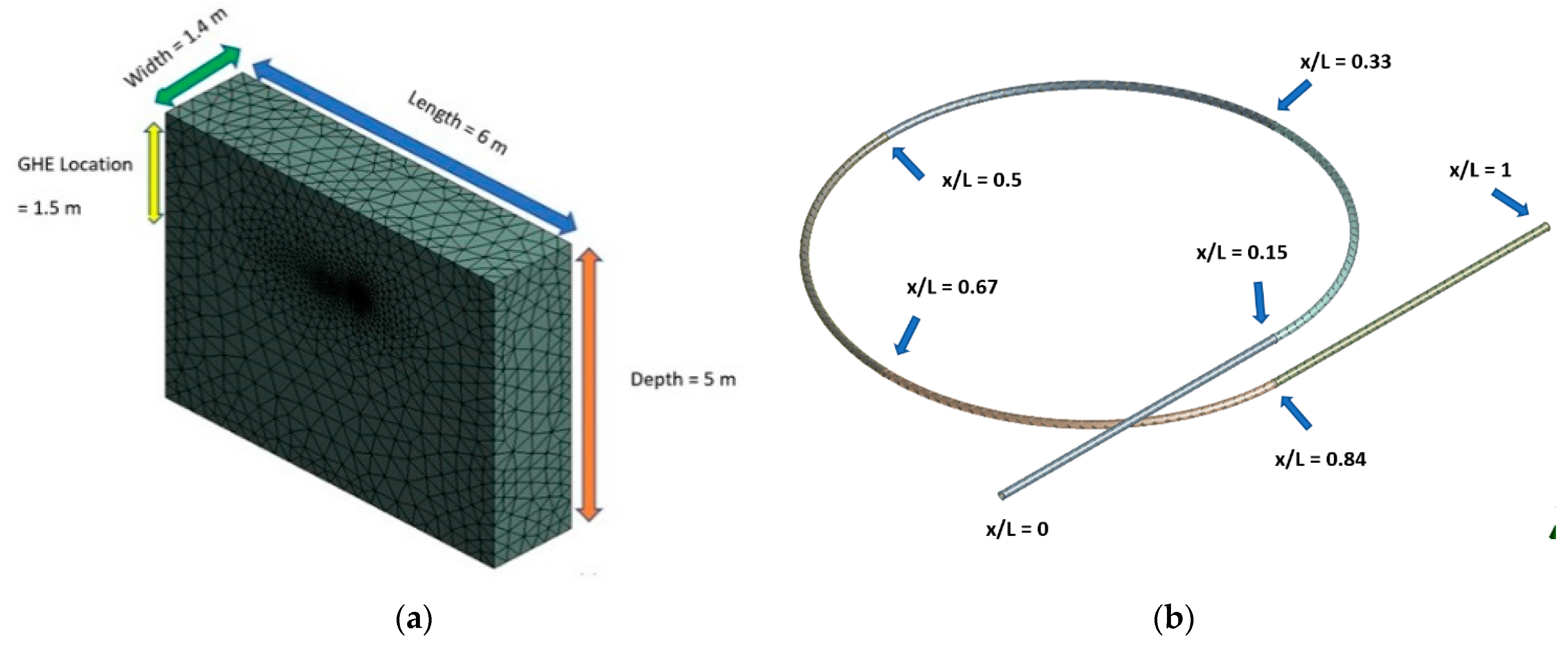

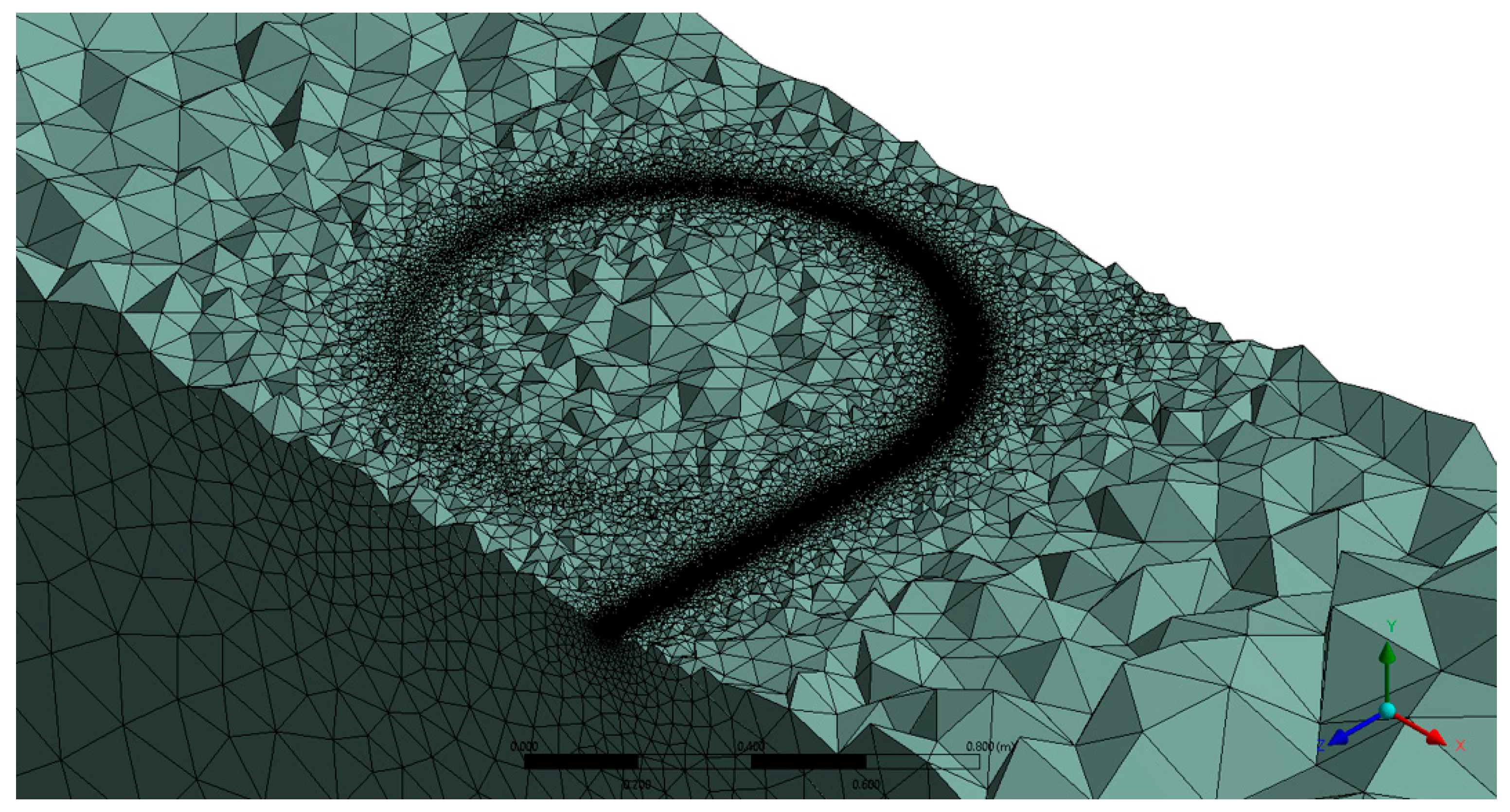

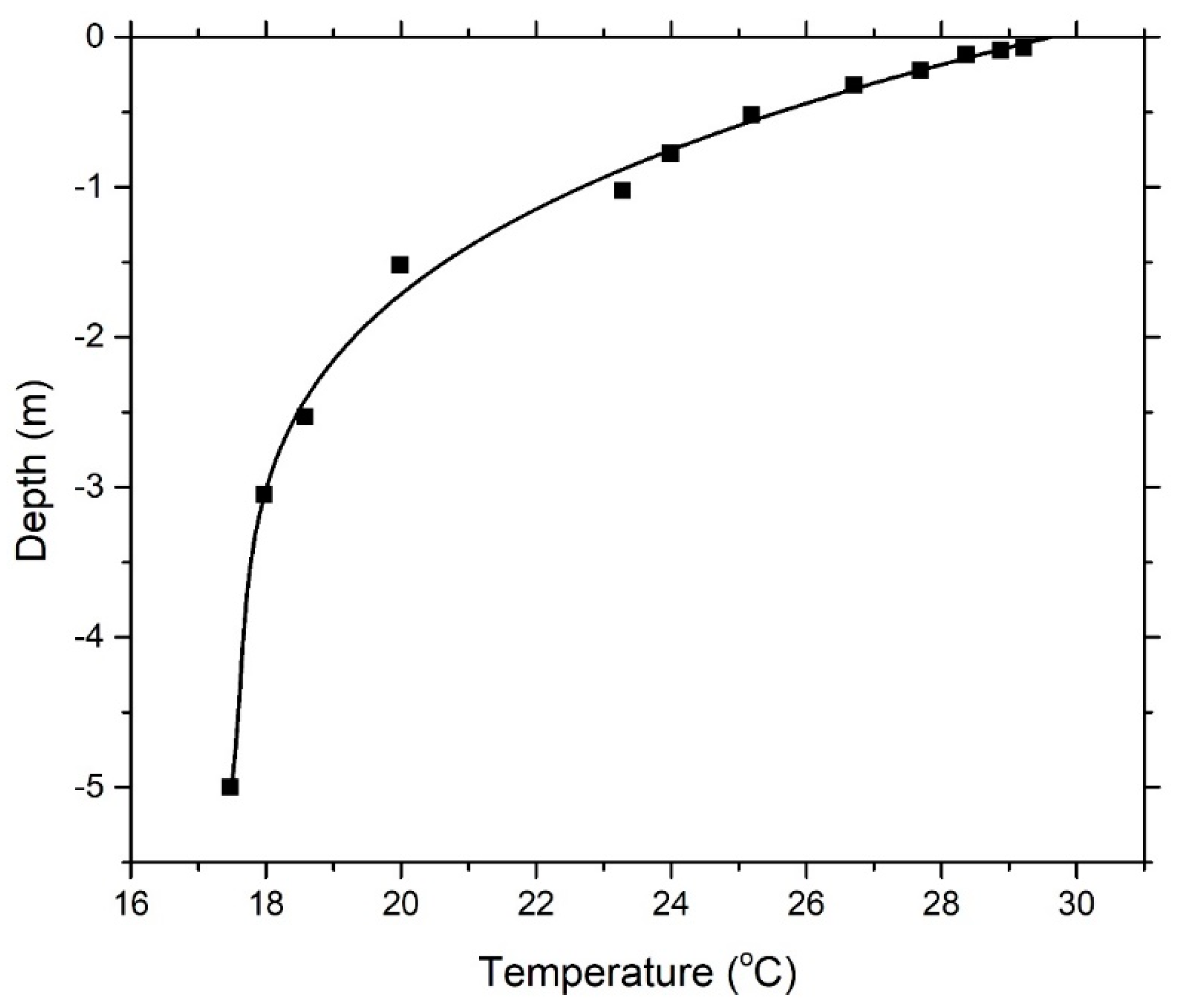

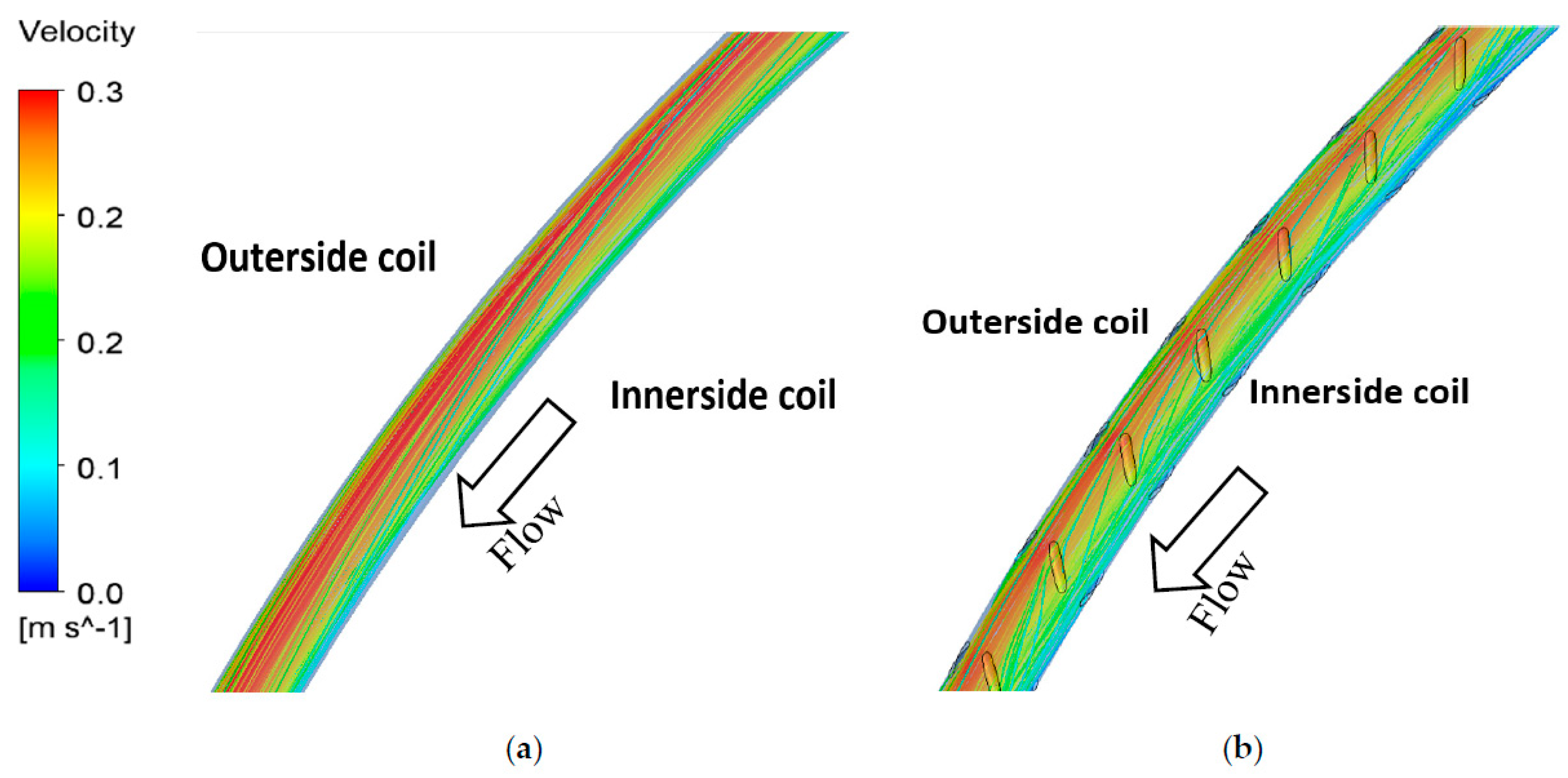
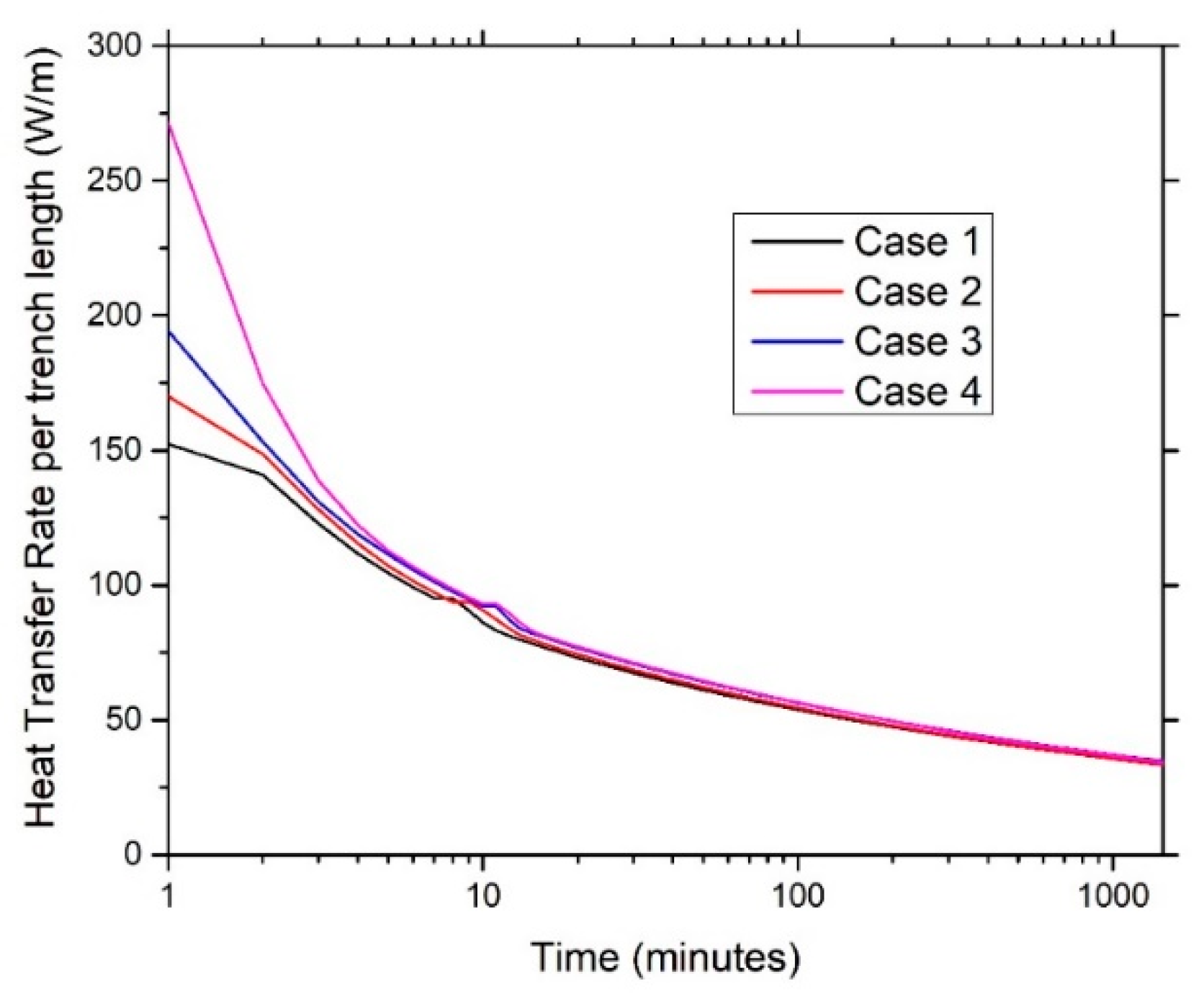
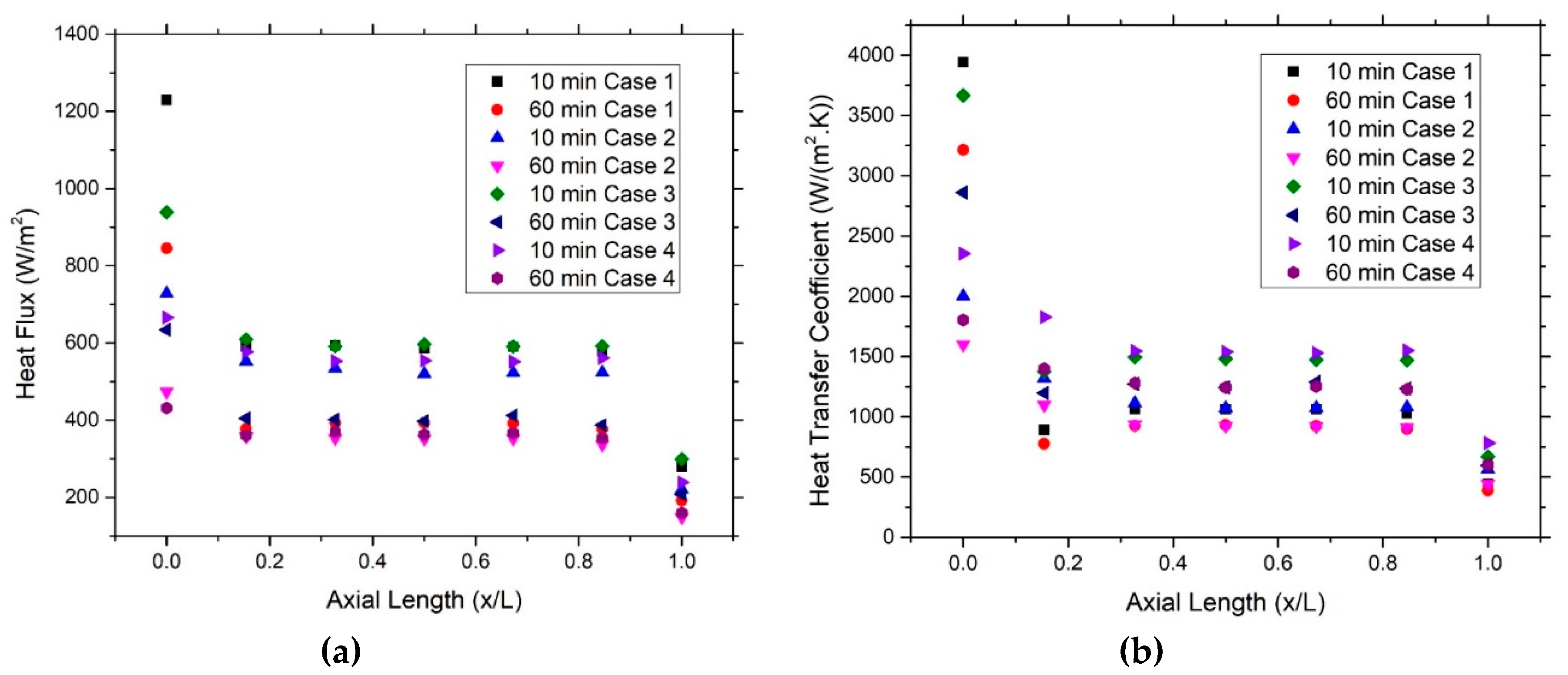

| Pipe Material | Inner Diameter (mm) | Wall Thickness (mm) | Density (kg/m3) | Specific Heat (J/kg∙K) | Thermal Conductivity (W/m∙K) |
|---|---|---|---|---|---|
| Composite: | |||||
| Copper (inner) | 14.9 | 0.65 | 8978 | 381 | 387.6 |
| LDPE 1 (outer) | - | 0.59 | 920 | 3400 | 0.34 |
| Copper | 14.9 | 1.24 | 8978 | 381 | 387.6 |
| HDPE | 14.9 | 1.24 | 955 | 2300 | 0.41 |
| Parameters | Density (kg/m3) | Heat Capacity (J/kg∙K) | Thermal Conductivity (W/m∙K) |
|---|---|---|---|
| Clay (water content: 27.7%) 1 | 1700 | 1800 | 1.2 |
| Sandy Clay (water content: 21.6%) 1 | 1960 | 1200 | 2.1 |
| Dry Sand (water content: 0%) 2 | 1815 | 620 | 0.3 |
| Case | Flow Rate (L/min) | Pipe Material | Type Tube | Flow Regime | Ground |
|---|---|---|---|---|---|
| Case 1 | 2 | Composite | Coil Plain | Laminar 1 | Clay |
| Case 2 | 2 | Composite | Coil DDIR | Laminar 1 | Clay |
| Case 3 | 4 | Composite | Coil Plain | Turbulent 1 | Clay |
| Case 4 | 4 | Composite | Coil DDIR | Turbulent 1 | Clay |
| Case 5 | 2 | Copper | Coil Plain | Laminar 1 | Clay |
| Case 6 | 2 | Copper | Coil DDIR | Laminar 1 | Clay |
| Case 7 | 2 | HDPE | Coil Plain | Laminar 1 | Clay |
| Case 8 | 2 | HDPE | Coil DDIR | Laminar 1 | Clay |
| Case 9 | 2 | Composite | Straight Plain | Turbulent 2 | Clay |
| Case 10 | 4 | Composite | Straight Plain | Turbulent 2 | Clay |
| Case 11 | 2 | Composite | Coil Plain | Laminar 1 | Sand |
| Case 12 | 2 | Composite | Coil DDIR | Laminar 1 | Sand |
| Case 13 | 2 | Composite | Coil Plain | Laminar 1 | Sandy Clay |
| Case 14 | 2 | Composite | Coil DDIR | Laminar 1 | Sandy Clay |
| GHE | QC-c | QC-s = QC | V | Equation (11) | ||||
|---|---|---|---|---|---|---|---|---|
| W/m | W/m | W/m | m3/s | Pa/m | Pa/m | Pa/m | ||
| Case 1 | 40.8 | 13.8 a | 27 | 3.333 × 10−5 | 219 | 65 a | 154 | 1.96 |
| Case 2 | 41.1 | 13.8 a | 27.3 | 3.333 × 10−5 | 395 | 65 a | 330 | 1.98 |
| Case 3 | 42.5 | 14.7 b | 27.8 | 6.666 × 10−5 | 676 | 205 b | 471 | 1.89 |
| Case 4 | 42.4 | 14.7 b | 27.7 | 6.666 × 10−5 | 1431 | 205 b | 1226 | 1.88 |
© 2020 by the authors. Licensee MDPI, Basel, Switzerland. This article is an open access article distributed under the terms and conditions of the Creative Commons Attribution (CC BY) license (http://creativecommons.org/licenses/by/4.0/).
Share and Cite
Ariwibowo, T.H.; Miyara, A. Thermal Characteristics of Slinky-Coil Ground Heat Exchanger with Discrete Double Inclined Ribs. Resources 2020, 9, 105. https://doi.org/10.3390/resources9090105
Ariwibowo TH, Miyara A. Thermal Characteristics of Slinky-Coil Ground Heat Exchanger with Discrete Double Inclined Ribs. Resources. 2020; 9(9):105. https://doi.org/10.3390/resources9090105
Chicago/Turabian StyleAriwibowo, Teguh Hady, and Akio Miyara. 2020. "Thermal Characteristics of Slinky-Coil Ground Heat Exchanger with Discrete Double Inclined Ribs" Resources 9, no. 9: 105. https://doi.org/10.3390/resources9090105





